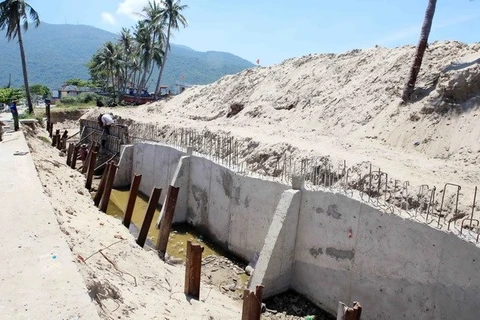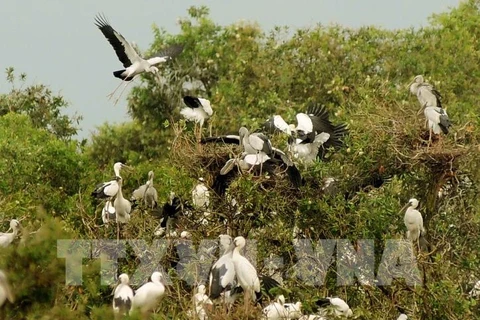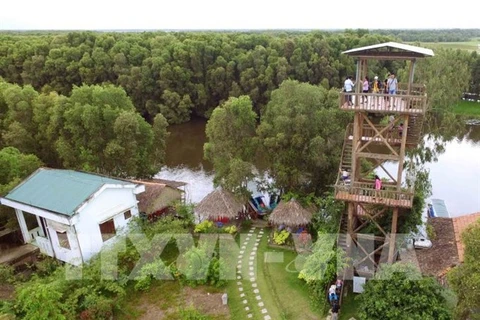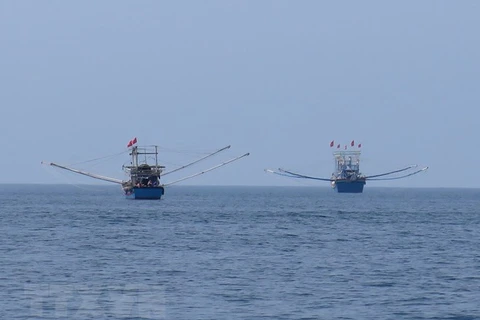Hanoi (VNA) – The loss and degradation of wetland areas are occurring more rapidly than in any other ecosystem due to large-scale land use changes, infrastructure development, altered water flow, and the impact of climate change.
The shrinking of natural wetlands and their ecosystems has accelerated over recent years, said Assoc. Prof., PhD. Nguyen Thu Ha from the Hanoi University of Science at the Vietnam National University (VNU-HUS), citing the decline in sea grass as a key example. About 40-50 percent of Vietnam’s sea grass meadows have been destroyed due to human activities – such as marine navigation, destructive fishing, tourism, and aquaculture – she said, adding that natural disasters, unusual water flow, and increased sediment loads along rivers during rainy season pose a further threat to the national sea grass coverage.
Over the last five years, 30 percent of sea grass coverage in waters off the coast of Khanh Hoa have been lost, while sea grass meadows along the shores of Quang Ninh and Hai Phong have completely disappeared as a consequence of human development projects, Ha noted.
A survey of more than 200 near-shore coral reefs conducted by the Institute of Oceanography in Nha Trang shows that coral cover, which measures the proportion of reef surface covered by live stony coral instead of sponges or algae, is in alarming decline with only 1 percent of coral reefs recorded with high cover, while reefs with low coral cover account for up to 31 percent. Extensive use of explosives and poisonous chemicals like cyanide to catch fish has played a large part in the loss of many coral reefs off the islands of Co To, Bach Long Vi, and Con Dao.
Other experts also voiced great concern over changing hydrological conditions of wetlands caused by mass water discharge for irrigation projects, land reclamation, and exploitation of groundwater. When the water level drops, trees and plants die because they are deprived of their life-sustaining supplies, resulting in biodiversity loss in freshwater and saline wetlands and brackish marshes. At the same time, these human activities have also led to expanded saline water intrusion into farming lands.
Pollution in wetlands is another growing concern. Drainage and runoff from fertilised crops and pesticides in agriculture, pollutants from aquaculture, discharge of industrial waste, and the overexploitation of natural resources are among the main reasons behind the draining of wetlands.
According to a report by the Ministry of Environment and Natural Resources, export processing zones and industrial parks in the southern localities dispose of over 111,600 cu.m of wastewater – including 15 tonnes of suspended solids, 20 tonnes of BOD5, 1.6 tonnes of nitrogen, and 500 kg of phosphorus – into the Dong Nai and Sai Gon rivers each day. The amount of lindane in river-bed sediment in the basin of the two rivers reached around 6-32ug per kg. In the Red River Delta where pesticides are widely used in agriculture, the level of residual pesticides detected in the Red River estuaries during rainy season was often 23-28 times higher than the accepted limit.
This caused numerous mass fish die-offs along coastal areas and rivers in recent years, costing tens of billions of VND to farmers each year.
At the same time, a large area of natural forest, particularly mangrove forests, cajuput forests, and protection forests, has been cut down to be converted for other purposes, putting further pressure on preserving the wetland ecosystem.
Climate change is also taking its toll. According to Prof., PhD. Truong Quang Hoc from the VNU’s Central Institute for Natural Resources and Environmental Studies, climate change impacts the wetland ecosystem in different ways. Increases in temperature affect the growth of temperature-sensitive plants and animals, while rainfall decline reduces the area of inundated wetlands through drought and fuels higher greenhouse gas emissions due to the decomposition of organic matters like peat, cited Professor Hoc as an example.
In addition, the release of toxic chemicals into the ocean triggers a phenomenon called “red tide”, caused by algal blooms that are harmful to wildlife in the wetlands. The phenomenon often occurs along the shores of Binh Thuan, Khanh Hoa, and other central provinces, resulting in large fish die-offs and negatively affecting the environment and tourism.
However, most of these provinces face shortages in funding for projects to preserve and manage the wetlands and as such, very little action has been taken to ensure the long-term monitoring, data collection, and assessment of wetland biodiversity. –VNA
VNA

























